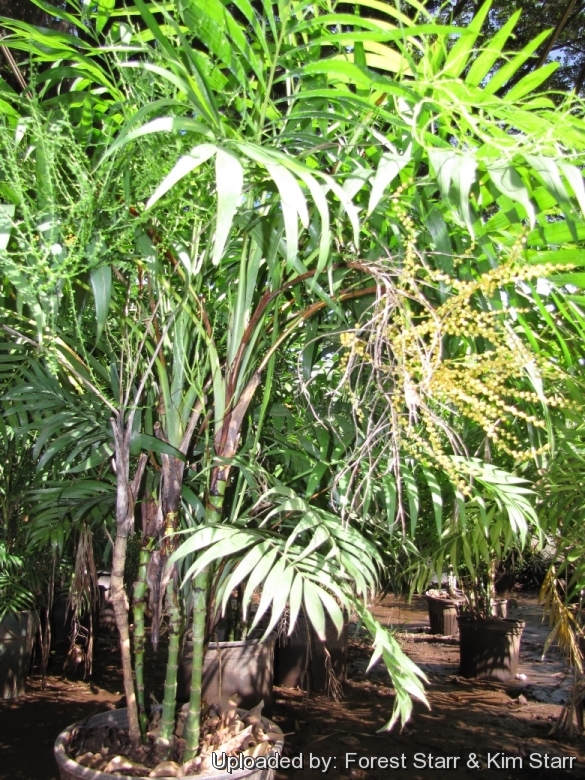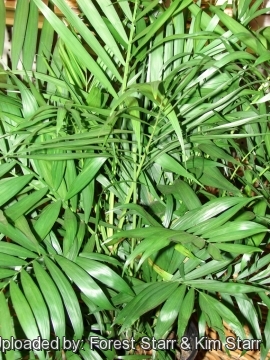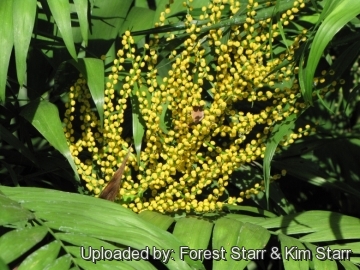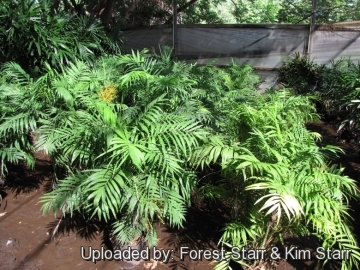Accepted Scientific Name: Chamaedorea elegans Mart.
Linnaea 5: 204. 1830

Collinia elegans (Chamaedorea elegans) Photo by: Forest Starr & Kim Starr
Habit at Resort Management Group Nursery Kihei, Maui, Hawaii (USA). February 09, 2011.
Origin and Habitat: Guatemala and Mexico.
Habitat: It is a small understory palm native to the rainforest.
Synonyms:
See all synonyms of Chamaedorea elegans
back
Accepted name in llifle Database:Chamaedorea elegans Mart.Linnaea 5: 204. 1830Synonymy: 16
back
Common Names include:
ENGLISH: Neanthe bella, Good-luck palm, Love palms, Parlor palm
CZECH (Čeština): Horská palma, Chamaedorea sličná
DUTCH (Nederlands): Mexicaanse dwerg palm, Kamerpalm
GERMAN (Deutsch): Zierliche Bergpalme, Bergpalme
ITALIAN (Italiano): Palma della fortuna, Palmetta, Neanthe bella
POLISH ( Polski): Chamedora wytworna
PORTUGUESE (Português): Camedórea-elegante, Pacaia
RUSSIAN (Русский): Хамедорея изящная
SPANISH (Español): Xate hembra, Palmera de salón, Pacaya, Camaedorea
Description: The Parlor palm, Chamaedorea elegansSN|24286]]SN|24286]], is a naturally dwarf palm that grows to 2–3 m tall. It is a very common palm, often sold at outlet nurseries. Probably the most commonly grown indoor palm in the world, it has been in use since Victorian times and is suitable for home or conservatory
Stems: Slender, erect, cane-like, bright green, shiny, will reach about 1,8 tall.
Crown: Each crown bears two to six upright to arching fronds.
Leaves: Alternate even-pinnately compound 10-30 cm long; leaflets on a pale rachis with 11-20 pinnae, glossy, dark green, without spines or obvious tomentum, lanceolate, evenly spaced along the rachis, slightly drooping and spreading in a single plan; Leaf margin entire.
Inflorescence/flowers: Very small, lemon yellow.
Blooming period: Flowers periodically throughout the year but in temperate climate they tend to bloom yearly in late winter to early spring, it flowers when still quite young. It is dioecious.
Fruits: Small black.
Bibliography: Major references
1) Forest & Kim Starr Chamaedorea elegans (Parlor palm, neanthe bella, good luck palm). Plants of Hawaii. <http://www.starrenvironmental.com>. Downloaded on 21 August 2014.
2) Don Ellison, Anthony Ellison “Cultivated Palms Of The World” UNSW Press, 01/mag/2001
3) Robert Lee Riffle, Paul Craft “An Encyclopedia of Cultivated Palms” Timber Press, Portland 2007
4) John Dransfield, Natalie W. Uhl, Conny B. Asmussen, William J. Baker, Madeline M. Harley, Carl E. Lewis: “Genera Palmarum. The Evolution and Classification of Palms.” Royal Botanic Gardens, Kew 2008
5) David Jones: “Palmen” Könemann, Köln, 2000
6) Breedlove, D. E. 1986. "Flora de Chiapas" Listados Floríst. México 4: i–v, 1–246.
7) CONABIO. 2009. "Catálogo taxonómico de especies de México." 1. In Ca. nat. México. CONABIO, Mexico City.
8) Henderson, A., G. Galeano & R. Bernal. 1995. "Field Guide Palms Americas" 1–352. Princeton University Press, Princeton, New Jersey.
9) Hodel, D. R. 1992. "Chamaedorea Palms" 1–338. The International Palm Society, Lawrence.
10) Pérez, A., M. Sousa Sánchez, A. M. Hanan-Alipi, F. Chiang Cabrera & P. Tenorio L. 2005. "Vegetación terrestre." 65–110. In Biodiver. Tabasco. CONABIO-UNAM, Mexico.
 Habit at Kula Ace Hardware and Nursery, Maui, Hawaii (USA). September 06, 2007. (Chamaedorea elegans) Photo by: Forest Starr & Kim Starr
Habit at Kula Ace Hardware and Nursery, Maui, Hawaii (USA). September 06, 2007. (Chamaedorea elegans) Photo by: Forest Starr & Kim Starr Fruit and leaves at Resort Management Group Nursery Kihei, Maui, Hawaii (USA). February 09, 2011. (Chamaedorea elegans) Photo by: Forest Starr & Kim Starr
Fruit and leaves at Resort Management Group Nursery Kihei, Maui, Hawaii (USA). February 09, 2011. (Chamaedorea elegans) Photo by: Forest Starr & Kim Starr Habit at Resort Management Group Nursery Kihei, Maui, Hawaii (USA). February 09, 2011. (Chamaedorea elegans) Photo by: Forest Starr & Kim Starr
Habit at Resort Management Group Nursery Kihei, Maui, Hawaii (USA). February 09, 2011. (Chamaedorea elegans) Photo by: Forest Starr & Kim Starr Bella habit at Home Depot Nursery Kahului, Maui, Hawaii (USA). January 17, 2008. (Chamaedorea elegans) Photo by: Forest Starr & Kim Starr
Bella habit at Home Depot Nursery Kahului, Maui, Hawaii (USA). January 17, 2008. (Chamaedorea elegans) Photo by: Forest Starr & Kim StarrCultivation and Propagation: It is a small, pretty versatile, single stemmed palm that likes a humus-rich, slightly acidic soil. It is cultivated in tropical and subtropical regions as garden plant and it is often cultivated in temperate regions as a slow growing houseplant. Its usually seen in clumps, since it looks more attractive this way, however this is just due to multiple seeds being sown together. It tolerating crowded roots and low light levels. Since lower leaves drop from the plant as it grows, older palms have all their foliage on top of the bright green, shiny stem.
Fertilization: Need a perfect fertilizer diet including all micro nutrients and trace elements or slow release fertilizer applied every one or two months, or according to package directions, using a fertilizer specifically formulated for palms.
Water Requirements: It tolerates low levels of humidity for short periods, though it prefers medium to high humidity. During the winter months, water is somewhat restricted and fertilizer is withheld until new growth starts in the spring.
Light: It can grow in semi-shade (light woodland) or in full sun and requires a bright spot with for indoor cultivation, though may tolerate low levels light.
Wind resistance: It does best protected from drying winds.
Hardiness: These palms are hardy in the landscape in USDA zones 10B-11.
Roots: Usually not a problem
Maintenance: For the healthiest and most attractive plant, keep the cat palm pruned. Remove any yellow-brown, diseased, damaged or drying fronds, but do not prune if the frond still has some green colour. Palms recycle nutrients from dead or dying fronds and use them for healthier fronds.
Uses: Ornamental: It is cultivated as an ornamental bush, and planted in gardens and parks.
Propagation: This palm reproduces sexually by seeds. The horticultural method of air-layering is applicable to the Chamaedorea elegansSN|24286]]SN|24286]]. This the only example of air layering propagation in the palm family













